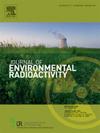Revisiting the historical tritium levels in precipitation in Greece – Preliminary assessment of groundwater transit times
IF 1.9
3区 环境科学与生态学
Q3 ENVIRONMENTAL SCIENCES
引用次数: 0
Abstract
The radioactive isotope of hydrogen, known as tritium (3H), is very often used as a dating tool in hydrogeological studies, since it enters the water cycle as part of the water molecule through precipitation. However, the assessment of groundwater transit times and recharge often requires knowing the local historical records of tritium levels in precipitation during the previous seven decades, or the tritium in precipitation (TIP) time series. Here, we compiled all tritium records in precipitation in Greece, with the majority of stations showing sporadic measurements, with the aim of reconstructing a TIP for groundwater dating purposes. The monitoring station of Vienna proved to be more reliable for filling the gaps in the time series than the Ottawa station. Conventional methods to fill the TIP gaps, such as the correlation method (CM), were compared with more advanced machine learning tools, such as the Convolutional Neural Networks (CNN). The comparison showed that the artificial Intelligence Method (AIM) performed best, due to its ability to capture complex nonlinear trends that are usually inherent in real-world data. The preliminary qualitative assessment of groundwater tritium data from Greece, in comparison to the TIP, showed the occurrence of groundwaters of mean transit times ranging from a few years to decades. Better incorporation of groundwater transit times and recharge rates into the study of aquifer systems is essential for developing strategies for sustainable water management in Greece and worldwide.
重新考察希腊降水中的历史氚水平-地下水过境时间的初步评估。
氢的放射性同位素,被称为氚(3H),在水文地质研究中经常被用作测年工具,因为它通过降水作为水分子的一部分进入水循环。然而,对地下水运移时间和补给的评估通常需要了解过去70年当地降水中氚水平的历史记录,或者降水中氚(TIP)时间序列。在这里,我们汇编了希腊降水中的所有氚记录,大多数站点显示零星测量,目的是重建地下水年代测定的TIP。事实证明,维也纳监测站比渥太华监测站更可靠地填补了时间序列的空白。填补TIP空白的传统方法,如相关方法(CM),与更先进的机器学习工具,如卷积神经网络(CNN)进行了比较。比较表明,人工智能方法(AIM)表现最好,因为它能够捕捉复杂的非线性趋势,这些趋势通常是现实世界数据中固有的。与TIP相比,对希腊地下水氚数据的初步定性评估表明,地下水的平均过境时间从几年到几十年不等。更好地将地下水过境时间和补给率纳入含水层系统的研究,对于制定希腊和全世界可持续水管理战略至关重要。
本文章由计算机程序翻译,如有差异,请以英文原文为准。
求助全文
约1分钟内获得全文
求助全文
来源期刊

Journal of environmental radioactivity
环境科学-环境科学
CiteScore
4.70
自引率
13.00%
发文量
209
审稿时长
73 days
期刊介绍:
The Journal of Environmental Radioactivity provides a coherent international forum for publication of original research or review papers on any aspect of the occurrence of radioactivity in natural systems.
Relevant subject areas range from applications of environmental radionuclides as mechanistic or timescale tracers of natural processes to assessments of the radioecological or radiological effects of ambient radioactivity. Papers deal with naturally occurring nuclides or with those created and released by man through nuclear weapons manufacture and testing, energy production, fuel-cycle technology, etc. Reports on radioactivity in the oceans, sediments, rivers, lakes, groundwaters, soils, atmosphere and all divisions of the biosphere are welcomed, but these should not simply be of a monitoring nature unless the data are particularly innovative.
 求助内容:
求助内容: 应助结果提醒方式:
应助结果提醒方式:


